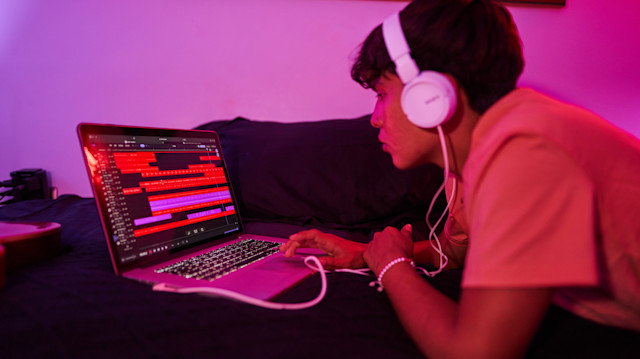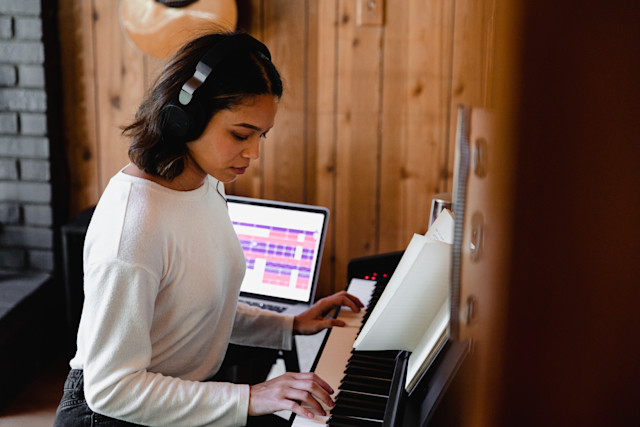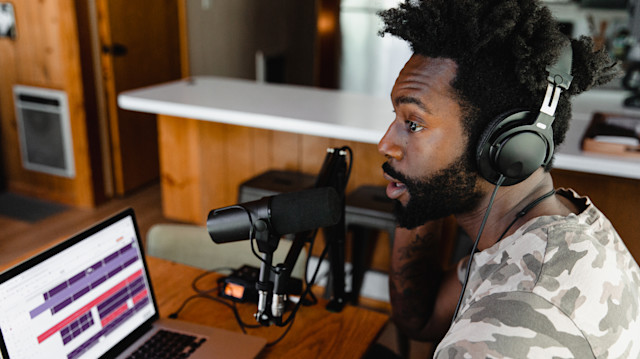What Is Royalty-Free Music and How To Use It in Your Audio Productions
November 7, 2023 / Soundtrap

You've probably heard the term "royalty-free music" being thrown around on YouTube and TikTok and the like. But what exactly does it mean, and how can you use it to enhance your songs?
Royalty-free music allows artists access to a vast library of professionally produced music for their projects. Whether you're a singer, songwriter, or podcast content creator, incorporating royalty-free music into your work can add depth, emotion, and a professional touch to your compositions.
We're taking a closer look into the world of royalty-free music, what it is (and isn't), and how you can unlock its potential for elevating your music and podcast production using Soundtrap's sound library to create a captivating and polished final product.
What is royalty-free music?
When music is referred to as royalty-free, the creator or user can utilize the music without paying royalties or additional fees per use. It's music that can be used legally and affordably by content creators and businesses worldwide.
However, it’s not to be confused with copyright-free or claim-free music. Copyright protection does apply to royalty-free music.
Is it really free?
Don't get too hung up on the "free" part. While royalty-free music can help you use tunes in your projects without hearing the cha-ching of your bank account compared to traditional licensing, in which you might need to mortgage your studio gear to get the rights, there’s usually a cost involved.
Payment for use occurs once or regularly if you subscribe to a service that offers royalty-free music. Soundtrap's sound library does offer a 100% free tier, which gives you access to a portion of the entire sound library.
To access the full catalog of over 25.000 loops and sounds, you'll need a paid subscription with Soundtrap.
The creators of royalty-free music usually receive a one-time purchase fee or a portion of the subscription cost from your streaming service or music-producing platform. If the music wasn't royalty-free, the creator of the music would be entitled to royalty payments each time the music is played or streamed.
How is royalty-free music different from traditional licensing?
Royalty-free music provides a simple and cost-effective solution for content creators, music producers, and businesses to use music in their projects. However, it's improbable you'll find music from famous, high-grossing artists as you would with traditional licensing.
Obtaining a traditional license for the use of a particular piece of music often requires negotiations, fees, and additional paperwork, which adds up in time, effort, and expense. For example, to feature a Beatles song on a single episode of "Mad Men," creator Matthew Weiner paid $250,000 in licensing fees for the use of their song, "Tomorrow Never Knows."
How does royalty-free music work?
With Soundtrap, once you sign up for an account, you’ll gain access to a wealth of tracks you can easily import to your song project or podcast recording.
For example, Soundtrap provides a vast library of royalty-free loops and samples. Just access the loops tab inside the studio, and you're good to go! Soundtrap also offers a 1-month free trial to any of our plans.

Soundtrap provides a vast library of royalty-free loops and samples.
What's the benefit of using royalty-free music?
Try to wrap your mind around the sheer volume of content uploaded to YouTube alone every minute of the day. It's mind-boggling! Now, imagine the vast number of YouTube creators across multiple countries with varying laws, all trying to procure individual traditional music licenses to use certain soundtracks on their videos. It would be an impractical, expensive, time-consuming task.
Fortunately, music licensing subscriptions offer a manageable solution, providing creators with a convenient and affordable means to access an extensive library of royalty-free music without the hassle of obtaining individual licenses.
In addition to the practical reasons, royalty-free music offers creators the following additional benefits.
Access high-quality music at a much lower cost
The music can be easily found and downloaded from online platforms
Royalty-free music libraries like Soundtrap offer a wide variety of professionally produced tracks to match the style and theme of your projects
Common Misconceptions About Royalty-Free Music
Royalty-free music often gets shrouded in confusion and misinformation. To help you better understand what it really entails, let’s debunk some popular myths making the rounds on the internet and social media by setting the record straight.
Misconception 1: It’s Low Quality
The assumption that royalty-free music is inferior to other types of music likely stems from the misbelief that if a piece of music does not require royalties, it must not be as valuable.
However, while you may encounter amateurish and generic tracks, you'll also likely discover professional compositions created by talented artists. Today, most platforms, like Soundtrap, offer high-quality, royalty-free music.
Misconception 2: The Tracks All Sound the Same
People often assume that royalty-free music libraries consist of a limited selection of generic tracks. While this may have been the case in the past, the landscape has significantly evolved to a vast selection of royalty-free music across genres, moods, and instruments, catering to a wide range of creative projects.
Misconception 3: It Can’t Be Used for Commercial Projects
Many people mistakenly believe that royalty-free music is exclusively suitable for personal use. In reality, many royalty-free music licenses cater to commercial purposes, such as in advertisements, films, podcasts, and even releasing your own music that incorporates royalty-free loops and samples.
Finding Royalty-Free Music
You can easily get royalty-free music for your music productions or podcasts with a few simple steps.
Start by identifying the specific genre or theme of music you are looking for to suit your production.
Royalty-free music libraries like Soundtrap and Splice Sounds offer a wide variety of professionally produced tracks to match the style and theme of your projects. Visit their libraries and browse through the variety of sounds available on those platforms.
Consider trying out royalty-free music services and combine them with a digital audio workstation (DAW) like Soundtrap that provides both tools for music production and audio content.
Using Soundtrap's Royalty-Free Sound Library in Music and Podcasts
With its vast collection of high-quality sounds and intuitive interface, Soundtrap's royalty-free sound library opens up a world of possibilities for musicians and podcasters and simplifies the process of finding the perfect audio elements for your projects.
How to Use Royalty-Free Music For Music Production
Enhance your creative projects by following these detailed steps and tips for effectively using royalty-free music for your music production.
Begin by determining the purpose. Are you creating a new song, background score, podcast jingle, or soundtrack for a video? This direction can help you choose the appropriate mood, genre, and style of music.
Browse through Soundtrap's music library by opening up the loops tab, divided into different categories, such as loops, one-shots, presets, and samples.
Spend some time exploring each category to get a feel for the vast array of content available, including trending genres like Phonk, Drill, Lo-Fi, K-Pop, and more.
Take advantage of the filtering and search options within the loops tab to find specific keywords related to the sound you're looking for.
Preview any sound by clicking on it before importing it into your project.
When you've found a sound that fits your project, click on it to import it, and it will automatically appear in your project's timeline.
Drag and drop the sound to any desired location or use it as a starting point for your composition.
Tweak it to match your vision with mix and mastering tools that adjust the volume, manipulate the pitch, add effects and filters, loop the sound, or cut it to the desired length.
Use Sountrap's feature to collaborate with other artists or podcasters to share your project with others. They can access the royalty-free sound library to add their elements.
Ways to Incorporate Royalty-Free Music for Podcasts
Incorporating royalty-free music into your podcasts can enhance the listening experience for your audience. It adds a professional touch, helps set the mood, and elevates the overall quality of your episodes.
Here are six ideas to effectively incorporate royalty-free music into your podcasts.
Intro and outro music
The transition between segments or topics
Ambient or instrumental tracks play softly in the background
Jingles or music beds to accompany advertisements or sponsorships
Music cues for recurring segments or signatures

Incorporating royalty-free music into your podcasts can enhance the listening experience
Final Tips for Using Royalty-Free Music
Royalty-free music enables aspiring musicians and content creators to enhance their creations without the need to pay royalties for each use or obtain individual licenses. To make the most of this valuable resource, follow this helpful advice.
Review Licensing Agreements
Remember to understand the specific terms, ensuring the music is indeed royalty-free and can be used for commercial purposes. Soundtrap's licensing agreement for its royalty-free music can be found here.
Give Credit to the Artist
Some sounds and music may require attribution. Check the sound details and provide credit to the artist or musician accordingly in your project or podcast description. This practice demonstrates respect for their work, helps promote their talent, and builds a network of collaborators within the industry. With Soundtrap, no attribution credit is necessary for using loops, sounds, or samples.
Explore Soundtrap’s Loops and Samples Library
Ready to turn those creative sparks into a roaring fire? Soundtrap is the all-in-one platform for everything you need to create amazing music or podcast productions. Try out thousands of royalty-free sounds, including loops, samples, one-shots, and sound effects. Sign up for Soundtrap and get started today!
Soundtrap — the online music studio
Making music is more than just a hobby — it’s a form of self-expression, a way to unleash your creativity, and a means for you to bring your unique voice to the world.
Soundtrap is the ultimate audio production software for music makers and producers to easily collaborate and create music online, with thousands of audio loops, instruments, and samples only a click away.
Get started with Soundtrap today!